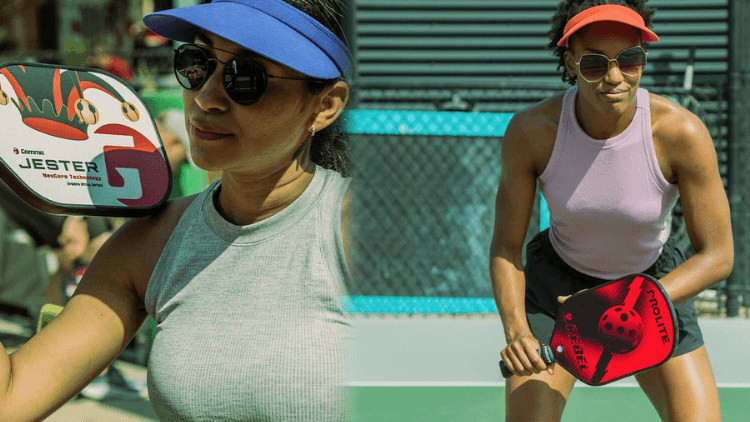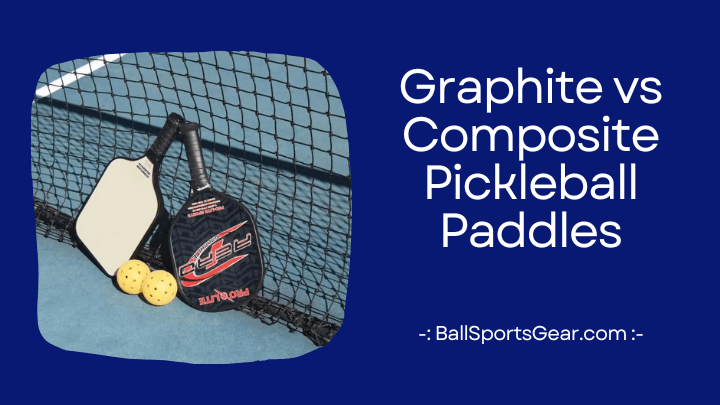A solid paddle is essential for playing pickleball, which is a fast-paced, enjoyable activity. But how do you pick the ideal paddle for your game when there are so many options? The material of the paddle is one of the most crucial variables to take into account.
Graphite vs composite pickleball paddles are the two primary materials utilized to make pickleball paddles. Both have advantages and disadvantages, and they are suitable for various playing philosophies and tastes. This article will describe the differences between composite vs graphite pickleball paddles and assist you in making the right decision.
What are Graphite Pickleball Paddles?
Graphite pickleball paddles are made of a thin layer of graphite that covers a core of another material, such as Nomex, aluminum, or polymer. Graphite is a form of carbon that is very light and strong. Graphite paddles are usually very thin and have a smooth surface. They are also very rigid and stiff, which means they do not flex or bend when hitting the ball.
Graphite pickleball paddles are ideal for players who value speed, accuracy, and maneuverability. They are easy to swing and control, and they offer a solid and consistent performance. They are also good for players who prefer to hit hard shots without losing control.
What are Composite Pickleball Paddles?
Pickleball paddles constructed of composite materials have a core consisting of Nomex, aluminium, or polymer underneath a coating of composite material. Any material that is composed of two or more distinct constituents is a composite material. Composite in pickleball mostly refers to a fibreglass and resin mixture.
Fibreglass is a particular kind of glass fibre that is woven into fabric and then given a resin coating to make it tough and long-lasting. Compared to graphite paddles, composite paddles have a thicker and rougher surface. They may also absorb part of the shock and vibration from hitting the ball since they are more flexible and sensitive.
Composite pickleball paddles are ideal for players who value power, control, and variety. They are more forgiving and versatile, and they offer more bounce and pop when hitting the ball. They are also good for players who like to add spin to their shots, as they have a textured surface that grips the ball well.

Pros And Cons Of Graphite Pickleball Paddles
Pros
Lightweight: Graphite paddles are usually the lightest paddles available, weighing between 6 to 8 ounces1. This makes them easy to maneuver and swing, which can improve your speed and reaction time.
Control: Graphite paddles offer excellent control over the ball, as they have a solid and consistent surface that does not deform or change shape when hitting the ball. This allows you to place the ball where you want it with precision and accuracy.
Power: Graphite paddles also offer good power, as they have a rigid and stiff surface that transfers most of the energy from your swing to the ball. This can help you hit harder shots without losing control.
Cons
Cost: Graphite paddles are usually more expensive than composite paddles, as they require more advanced technology and materials to produce. They can range from $80 to $200 or more2, depending on the brand and quality.
Durability: Graphite paddles may not be as durable as composite paddles, as they can crack or chip over time due to wear and tear or extreme temperatures. They may also lose some of their power with extended use, as they can become brittle or dull.
Spin: Graphite paddles may not be ideal for players who like to add spin to their shots, as they have a smooth surface that does not grip the ball well. This can make it harder to create topspin or backspin on the ball, which can affect your shot placement and trajectory.
Pros And Cons of Composite Pickleball Paddles
Pros
Durability: Composite paddles are very durable and can withstand repeated impacts without cracking or chipping. They are also resistant to weather and UV damage, making them suitable for outdoor use.
Bounce: Composite paddles have a rougher surface than graphite paddles, which gives them more bounce and pop when hitting the ball. This allows players to generate more power and speed with less effort.
Spin: Composite paddles also have more texture than graphite paddles, which helps create more spin and curve on the ball. This gives players more options and versatility in their shots.

Cons
Weight: Composite paddles are typically heavier than graphite paddles, ranging from 7 to 9 ounces or more. This makes them harder to swing and control, especially for players with weak wrists or arms.
Control: Composite paddles are less responsive than graphite paddles, as they have more flex and vibration when hitting the ball. This makes them less precise and consistent in their performance.
Power: Composite paddles are too powerful for some players, as they can send the ball out of bounds or into the net with too much force. Players who prefer to play with finesse or touch may find composite paddles overwhelming in this aspect.
| Feature | Graphite Paddles | Composite Paddles |
|---|---|---|
| Weight | Lighter, usually between 6 and 8 ounces²³ | Heavier, usually between 7 and 9 ounces²³ |
| Texture | Smoother and harder, less likely to create spin¹²³ | Rougher and softer, more likely to create spin¹²³ |
| Price | More expensive, usually over $100¹²³ | More affordable, usually under $100¹²³ |
| Power | Higher, due to the stiffness and rigidity of the material¹² | Lower, due to the flexibility and elasticity of the material¹² |
| Control | Higher, due to the lighter weight and responsiveness of the paddle¹² | Lower, due to the heavier weight and vibration of the paddle¹² |
| Durability | Lower, prone to cracking or chipping over time²⁴ | Higher, resistant to cracking or chipping over time²⁴ |
Frequently Asked Questions
A: Graphite paddles are made of a thin layer of graphite over a honeycomb core, while composite paddles are made of a fiberglass or carbon fiber face over a honeycomb core. Graphite paddles are lighter, stiffer, and more responsive, while composite paddles are heavier, more durable, and more powerful.
A: There is no definitive answer to this question, as different beginners may have different preferences and goals. However, some general guidelines are that graphite paddles are easier to swing and control, while composite paddles are more forgiving and versatile. Graphite paddles may also be more suitable for players who have weak wrists or arms, or who play indoors or in quiet areas. Composite paddles may be more suitable for players who have strong wrists or arms, or who play outdoors or in noisy areas.
A: Once more, there is no clear-cut response to this query because different advanced players may have various playing methods and tactics. According to certain basic rules, however, composite paddles are preferable for players who value power, control, and variation, while graphite paddles are better for those who value speed, precision, and maneuverability. Additionally, players who use finesse or touch may benefit more with graphite paddles, whilst those who use power or spin may benefit more from composite paddles.
Conclusion
Graphite vs composite pickleball paddles are both popular and effective options. Which one is superior depends on your playing style and preferences, therefore there is no clear winner. However, before making a choice, you should carefully weigh the benefits and drawbacks of each material of graphite vs composite pickleball paddles.
Generally speaking, composite paddles are excellent for players who prefer durability, bounce, and spin, while graphite paddles are best for those who favour control, power, and lightness. Other elements like the paddle’s core, shape, size, and grip should also be taken into account as they may have an impact on your comfort and performance.

